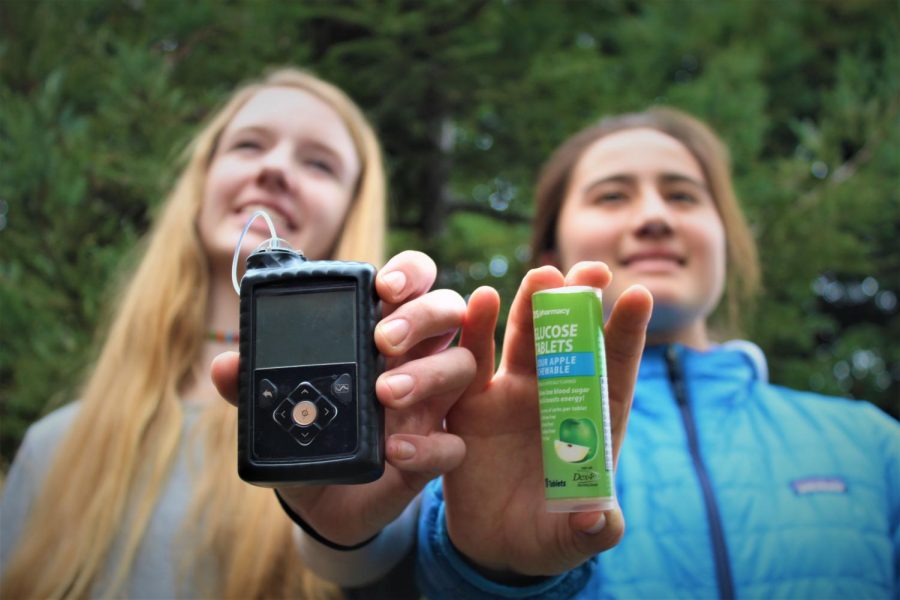Madeleine Cunningham and Makya Whiting show their insulin pump and glucose tablets.
Type 1 Diabetes
Diabetes Mellitus or Type 1 diabetes is an autoimmune disease in which the insulin-producing cells in the pancreas are destroyed. At this point, the body cannot produce the insulin it needs.
Insulin guides the sugar in one’s blood to other parts of the body, including the brain, muscles, and tissues. Without insulin, glucose builds up in the bloodstream, resulting in high blood sugar which can lead to serious health issues, including heart attacks, organ damage, strokes, and even death.
According to Dr. Puneet Arora, the vice president and head of clinical development at Principia Biopharma, the disease is usually diagnosed at a young age; however, the periods of the diagnosis vary.
Symptoms of Type 1 typically appear gradually. They may include thirst, fatigue, extreme hunger, and weight loss, causing the indications of the disease to be challenging to recognize.
Currently, the only way to treat this disease is to find a replacement for the vital hormone insulin.
Type 1 Diabetes Statistics by Joley Bove
“We do not yet know another way to regrow the beta cells or make the body produce insulin again,” Arora said.
Due to the complexity of the disease, people with Type 1 diabetes have limited options for treatment.
The less common treatment is the transplant of the pancreas. Because the body can reject foreign tissue, patients must remain on drugs for the rest of their lives that suppress the immune system.
The more standard and less-invasive option is insulin injections.
Luckily, due to the advancement of technology and equipment, people with diabetes have an easier time managing their insulin and glucose levels compared to 20 years ago.
The insulin pump is one of the most commonly used pieces of equipment for Type 1 diabetics. This electronic device mimics the role of the pancreas, automatically injecting rapid-acting insulin when it senses that the blood level is too high.
The blood glucose monitor continuously measures the glucose level within one’s bloodstream. Every few minutes, the monitor checks the numbers and when necessary, will alert the person with diabetes when their glucose levels aren’t at the correct range. “Normal” blood sugar levels are 100mg/l pre-meal and less than 140mg/l post-meal.
A common misconception is that people with diabetes are restricted from many foods, specifically carbohydrates, and sugar. Even though eating carbohydrates produces a spike in glucose levels, Type 1 diabetics don’t need to omit them from their diet entirely.
Incorporating complex carbs like brown rice, sweet potato, and vegetables can be beneficial since they are packed with nutrients and minerals. Although refined sugar isn’t ideal for a person living with diabetes, eating it in moderation won’t have a devastating impact on the body.
“The importance of meals in Type 1 diabetes is related to ensuring that there is adequate insulin taken to cover the food, so that blood sugars keep normal,” Arora said.
As long as the insulin to food ratio balances out, eating something such as a cupcake won’t affect the body in the long run. To balance the ratio, tracking carbohydrates and calculating insulin doses is an effective method that many use.
These advancements, although still difficult to manage, are more efficient than the technology from the past.
When Kimberly Callan, a teacher at Carlmont, was diagnosed, she treated her Type 1 diabetes with less efficient technology than those diagnosed today.
“When I was first diagnosed, blood glucose testing was pretty new. The machines used to measure blood glucose levels [glucometers] were bigger than they are now and took two minutes. Now, they take about five seconds,” Callan said.
Although today’s technology is sufficient, researchers are still working on ways to improve these inventions further.
“An exciting new idea is to develop a sensor that can measure glucose through the fluid in the eyes,” Arora said.

